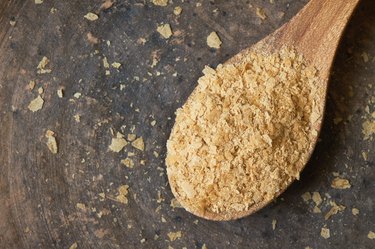
When it comes to recipes, baking and nutritional supplements, the question of brewer's yeast vs. yeast is one that often comes up. While the two share the same strain, there are some significant differences between brewer's yeast and baker's yeast that you should know about before using them.
Tip
There are several differences between brewer's yeast and baker's yeast including their uses, health factors and composition.
Video of the Day
Brewer’s Yeast vs. Yeast
Brewer's yeast is best known for its role in the production of beer and wine. According to the University of Rochester Medical Center, brewer's yeast is collected during the process of brewing beer. But it is also a nutritional supplement that many people use for various health ailments such as lowering blood glucose in people with diabetes and helping to improve GI symptoms in people with irritable bowel syndrome.
Video of the Day
Both brewer's yeast and baker's yeast are made from strains of the Saccharomyces cerevisiae fungus, but each from different strains of this species. Brewer's yeast contains chromium, which is an essential nutrient that may help regulate blood sugar, according to the Cleveland Clinic. It is also considered a good source of B vitamins, which are needed to help a variety of enzymes do their jobs, according to Harvard T.H. Chan School of Public Health.
An October 2013 study published in the International Journal of Preventative Medicine found that adults with type 2 diabetes experienced a drop in their fasting blood glucose after receiving 6 tablets of brewer's yeast daily for 12 weeks. This was in comparison to the other group that received 6 placebo tablets. It's important to note that this study had less than 100 participants, with 21 being men and 63 women.
Additionally, a June 2013 study published in the Iranian Journal of Public Health found that adults with type 2 diabetes experienced a decrease in both systolic and diastolic blood pressure levels after receiving 1,800 milligrams of brewer's yeast or a placebo daily for 12 weeks. Again, like the study on blood glucose, this study had less than 100 participants, with 21 being men and 63 women.
Read more: How Does Vitamin B Complex Help Your Body?
What is Baker’s Yeast?
Baker's yeast is another name for the type of yeast you use to bake bread and other bakery products. You can find this type of yeast in various forms including fresh, liquid, instant and active dry. When mixed with sugar, baker's yeast releases carbon dioxide that expands the dough and makes it rise.
Baker's yeast is the primary leavening agent in the production of bread in its numerous forms, according to a July 2017 review in the Comprehensive Review in Food Science and Food Safety. Just like many other food items, dry yeast can expire. If your dough is not rising, check the "sold by" date on the yeast you're using. If it is old, toss it, and use a fresh package.
Additionally, storing unopened yeast in a cool place, away from the oven will help keep it usable. However, once you open a package of yeast, you need to store it in the refrigerator. To help yeast last longer, consider storing it in the freezer.
The nutritional information for 1 tablespoon of active dry baker's yeast, leveling agent, according to the USDA is:
- 13 calories
- 1.62 grams of protein
- 0.30 grams of fat
- 1.65 grams of carbohydrates
- 1.1 grams of fiber
- 0.0 grams of sugar
Read more: Foods to Eat if You Can't Have Yeast
Tips for Using Brewer’s Yeast
Once you know the differences in brewer's yeast vs. yeast, it's critical to understand the precautions when using brewer's yeast, especially when using it as a nutritional supplement. Brewer's yeast is available in several forms including a liquid, flakes, tablets or brewer's yeast powder.
If you're new to brewer's yeast, it is recommended to start with a smaller dose and work your way up to the recommended dosage. This will help you assess your tolerance level. While generally considered safe for most people at the recommended dosage, you may experience stomach upset and gas when taking brewer's yeast.
Combining brewer's yeast with certain medications such as monoamine oxidase inhibitors (MAOIs), which is often used when treating depression, or Demerol, a narcotic medication used for pain, is not recommended. Also, if you have gout or Crohn's disease, avoid taking brewer's yeast. Since there may be a connection between brewer's yeast and a drop in blood sugar levels, avoid taking as a supplement if you're on diabetes medication.
The connection between brewer's yeast and yeast infections is not totally clear, but some experts say if you have frequent yeast infections or are allergic to yeast, you should avoid brewer's yeast.
- International Journal of Preventative Medicine: "Brewer's Yeast Improves Glycemic Indices in Type 2 Diabetes Mellitus"
- Iranian Journal of Public Health: "Brewer’s Yeast Improves Blood Pressure in Type 2 Diabetes Mellitus"
- The Cleveland Clinic: "Chromium Tablets or Capsules"
- Harvard T.H. Chan School of Public Health: "B Vitamins"
- Comprehensive Reviews in Food Science and Food Safety: "Bread Dough and Baker's Yeast: An Uplifting Synergy"
- Mount Sinai Hospitals: "Brewer's Yeast"
- World Journal of Gastroenterology: "Saccharomyces Cerevisiae CNCM I-3856 in Irritable Bowel Syndrome: An Individual Subject Meta-Analysis"
- University of Rochester Medical Center: "Brewer's Yeast"
- United States Department of Agriculture, Food Data Central: "Leavening Agents, Yeast, Baker's, active Dry"